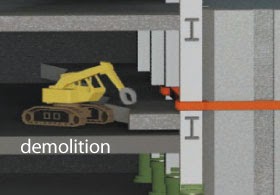High Rise Building Demolition - Bottom Up Method
High Rise Building Demolition -
Bottom Up Method
Kajima Corporation Buildings –
Demolition Methodology
“There
are so many quiet revolutions going on in tall buildings. Top-down construction
is one such revolution, and here is another—bottom-up demolition.”

Location
Tokyo
Completion Date
Tower
1: 1968
Tower
2: 1972Demolition Date
2008Height
Tower
1: 76 m (249 ft)
Tower
2: 65m (213 ft)Stories
Tower
1: 20
Tower
2: 17Primary Use
Office
The
demolition of older tall buildings is increasingly becoming an issue with the
impact on the environment and re-use of materials. The new Kajima method offers
a solution which addresses and improves upon typical demolition methods. This
method will improve the sustainability of a building through its lifespan and
final deconstruction. Aside from improving sustainability, this method also
decreases the impact of demolition on its surroundings.
|
|
|
| ||
Figure 1. Demolition sequence: March 08
|
Figure 2. Demolition sequence: May 08
|
Figure 3. Demolition sequence: July 08
|
A
high-rise construction boom in Japan during the 1960s and 1970s has resulted in
a large amount of aging towers. Building owners have an interest in demolishing
the old structures to replace them with more modern, safe, and work-friendly
buildings, but there are several issues to address in this process.
The
Kajima “Cut and Take Down Method” was developed to satisfy both safety and
environmental concerns. In April 2007, Kajima started to develop this new
demolition method to demolish its aging office headquarters buildings, which
were 76 meters tall and 65 meters tall.
Buildings
are usually demolished by placing heavy equipment and workers on the top floor
and then lowering the waste material down to ground level. The “Cut and Take
Down Method” alternatively allows the workers to start at the base and work
their way up. By starting at the bottom, gutting one floor, and then lowering
the entire building on jacks one floor at a time, all work can be performed
safely at ground level.

On
the 85 by 60 meter site, the two towers were situated quite close to another
office building and a residential building, emphasizing the need for a clean,
quiet demolition process. To accomplish this, temporary columns are used around
the structural column grid, the existing columns are replaced, and then
hydraulic jacks are placed where the existing columns were and the building can
be lowered to the next floor plate where the process is repeated.
The
hydraulic jacks each had a capacity of 1,200 tons, and supported the structure
through each cycle of lowering. A cycle would lower the whole building by 675
mm, which meant that five cycles were required for each floor (total of 3.375
meters). The total time to demolish a whole floor was six days: 2.5 days for
lowering and the remaining time to demolish the rest of the structure.
.
|
|
|
| |
Figure 3. Demolition process step 1: Cut the column. Cut length of 70 centimeters for a column and take off
| ||
|
|
| |
Figure 4. Demolition process step 2: Extend the jack stroke. Extend length of 70 centimeters for jack stroke
| ||
|
|
| |
Figure 5. Demolition process step 3: Take down all jacks. After doing step 1 & 2 for all columns, all jacks were taken down
| ||
|
|
| |
Figure 6. Demolition process step 4: Take out beams and floor slab of the floor above
| ||
A
“core wall and load transferring frame” system are utilized to temporarily
reinforce the structure to prevent any lateral movements due to wind or
earthquake forces. The core wall was 400–900 mm thick reinforced concrete and
was placed in the center of the floor plates up to the third level to take any
lateral forces of the superstructure. To ensure the transfer of lateral loads,
the load transferring frame was installed in steel and connected to the
existing structure. It was then tied into the core wall with a track-like
system, which would lock in place in the event of an earthquake.
The
new method allows the dismantled building to keep the same level of seismic and
wind resistance capability as its original design. It also reduces the amount
of noise as compared with typical top-down approaches, because all the work is
being completed at the ground level. Safety of workers is increased as well,
due to the location of all the work being at ground level as opposed to the
building top.

Figure
7. Removing columns after cutting
In
considering the reduction of site waste being sent to landfills, this new
method allows for a more efficient system of recycling and reusing. The
orderliness of the process means that the materials from each floor may be
sorted effectively so the maximum amount of material is sent to its rightful
place instead of batches of material getting sent to the landfill without
adequate sorting. The Kajima Towers were able to be sorted into 30 types of
materials for recycling, as opposed to a typical 20 at other demolition sites.
The recycling rate was over 90% for the interiors of the buildings, surpassing
the average 55%.
Although
this method was developed for a building with steel frame structure up to 20
stories high, it can be applied to larger-scale buildings as well. Furthermore,
this process is especially useful in densely built areas where typical
demolition may impact neighboring buildings. The demolition of the two Kajima
Towers was completed in nine months for the 20- and 17-story buildings. Though
the costs of this method may be 5–10% higher than traditional methods, the
total time of demolition can be decreased by 15%, increasing the turnover rate
of the site.

Figure
9. Core wall demolition














No comments
Post a Comment